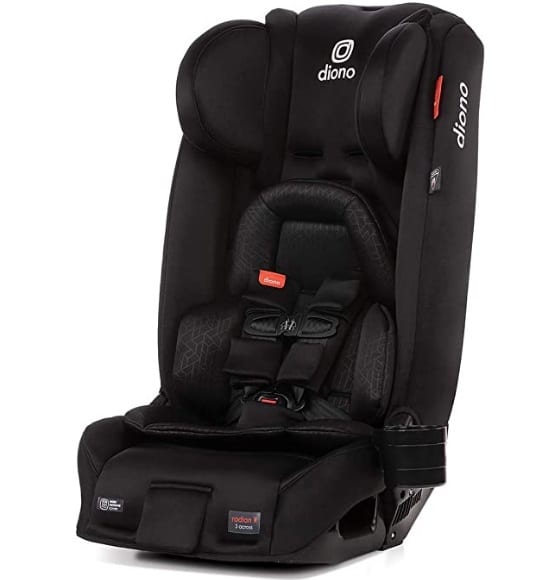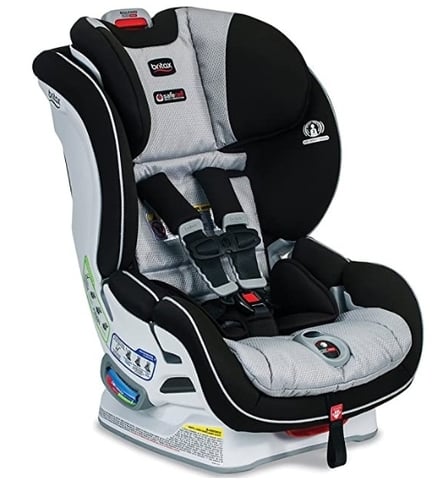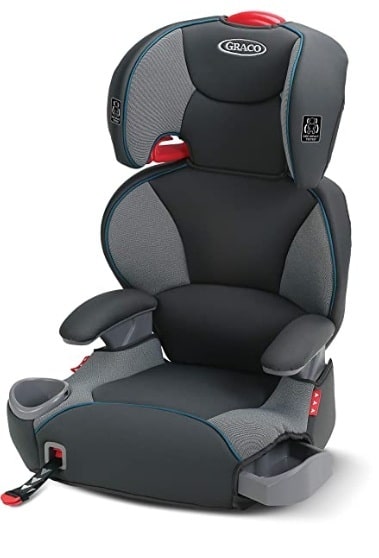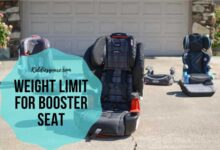Height and Weight Requirements for Booster Seats
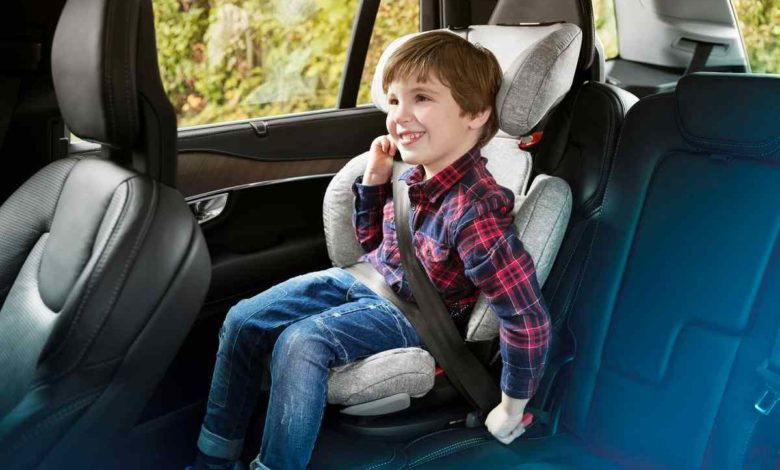
Moving from harnessed car seat to a booster seat is an important milestone in a child’s development. Height and weight requirements for booster seats are the prerequisite minimum requirement to ride in a booster. Your child must meet the two above conditions in order for them to wear a seat belt properly.
It is obvious that many parents do not know the minimum requirements for using a booster seat for a child. They don’t realize that there are significant difference between car seats and booster seats, the various types of car seats and booster seat safety. Therefore, in today’s article we will deal with these issues and many more.
Table of Contents
What is a Booster Seat?
For older children, a booster seat is needed when they are too big for a harnessed car seat but not big enough for an adult seat belt. A booster seat lifts the child so that both the lap and the shoulder portions of the seat belt passes in the right place around the child’s body. Since seat belts are built to accommodate grown adults, children need a booster to hold the seat belt correctly over their small bodies.
Difference Between Car Seat and a Booster Seat
The most significant difference between a car seat and a booster is that a car seat is any seat where the child uses a five-point harness as their restraint, also when a harnessed seat is properly tightened, it doesn’t give much freedom to the child to move out of position. Whilst a booster is any seat the child sits on and wears the vehicles seat belt across them as their restraint.

Height and Weight Requirements for Booster Seats
Studies have shown that car accidents remain a leading cause of death for children ages 4 to 13. Seat belts save lives, but when they don’t fit correctly it becomes difficult to protect your child during an accident – with Booster seat problem is solved.
As you or your child might be eager to switch on from harnessed car seats to booster seats, its important you don’t do so too early. Parents should also bear in mind that height and weight requirements for booster seats are required before purchasing any.
As your child grows, they switch into various types of safety restraints; from a rear-facing car seat to a forward-facing seat to a booster seat. Laws exist for the proper use of booster seats, but they differ from state to state.
A child ready for booster seats should at least be:
- Children who have outgrown forward-facing car seats but do not yet fit adult seat belts.
- Minimum of 5 years old or at least 50 inches (127 cm) tall
- And weigh a minimum of 55 Ibs (24.947kg).
Parents should also follow the specific guidelines for the booster seat they have acquired. All car seats and booster seats are designed and labeled with their own height and weight requirements. Follow these guidelines to decide if a particular seat is right for your child’s height and weight and to determine when they have outgrown their current seat.
Types of car seats
Rear-facing car seats

Rear-facing seats are for babies. From the time a baby leaves the hospital they should ride in a rear-facing seat. The American Academy of Pediatrics (AAP) recommends that babies be kept in rear-facing seats until age 2. If your baby’s feet hit the back of the vehicle seat or their legs bend naturally when in the car seat, it’s fine!!
Height and Weight Requirements Rear-Facing Seats:
Rear-facing seats usually fit babies of 29-32 inches and 4-30 lbs. For clarification do check your manufacturer guidelines.
Children should be in rear-facing seats through at least age 2 and until they reach the manufacturer’s maximum height and weight requirements.
Pros
- Portable
- Can be attached to strollers.
- Easy to carry out of the car
Con
- Once a baby surpasses the topmost limit on weight or height, then the seat must be replaced.
Check out Latest price here on Amazon
Convertible Car Seats
These types of car seats are for the toddler. It works as either a rear-facing or forward-facing car seat, depending on the size of the infant. It can use in the rear-facing position as long as possible until the child reaches the maximum height or weight requirements of manufacturer guidelines.
In general, convertible car seats fit up to 52 inches and 30-65 lbs. Always check manufacturer guidelines.
Pro
- It can be used longer with a greater range of weight and height, as the rear-facing seat can be converted to a forward-facing seat as the child grows.
Cons:
- Takes up more room.
- Cannot be attached to a stroller.
See Latest price convertible car seat on Amazon
Forward-Facing Car Seat
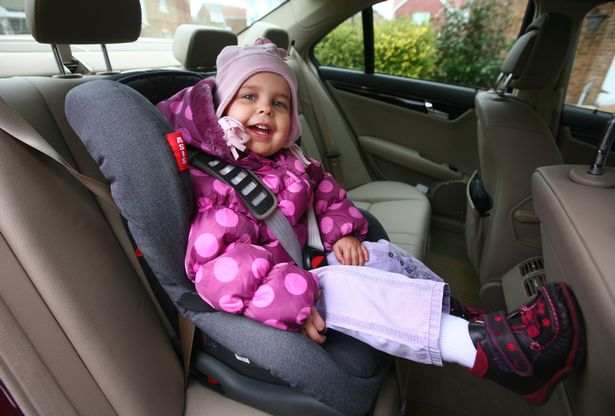
Use a forward-facing car seat for preschoolers, a minimum of 2 years till when there are 5. Until kids reach the height or weight limit of their seat, they should keep using it.
Note: It is essential for children to stay in rear-facing car seats as long as possible (until they reach the manufacturer’s maximum recommended height or weight).
The weight requirements for the forward-facing seat is anywhere from 50 to 100 pounds (22.6 to 45.4kg) depending on the manufacturer guidelines. The seat can be converted to a booster seat when your child is tall enough or weighs enough, but follow the manufacturer guidelines.
Check for Latest price on Amazon here
Booster Seat
It is used by children and Pre-Teen who have outgrown forward-facing car seats but do not yet fit adult seat belts. When preschoolers outgrew their car seats, they need a booster seat to help them sit properly on the car seat and use the safety belt.
The height and weight requirements for booster seats are pegged at a minimum of 50 inches (127 cm) and 55 Ibs (24.947kg). And they should sit in the back of the car until they’re 13 years old.
Types of Booster Seats
According to the National Highway Traffic Safety Administration (NHTSA), children can only be transferred to a booster seat when they have outgrown the height or weight limit of their forward- car seat.
Height and weight requirements for booster seats are very important and differs from each manufacturer. Car seats are secured into a car and use their own 5-point harness or safety belt.
A booster seat, on the other hand, is not installed in the car and doesn’t have its own safety belt. It is placed on the seat, and your child sits on it and buckles themselves in with the car’s own seat belt.
Booster seats are available in two styles: High-back and No-back. The owner’s manual will help determine the best option for the age and size of your child and the particular spec for your vehicle.
When kids reached a booster seat limits at 12-13 years (height and weight requirements of booster seats) they can comfortably move to an Adult seat and use the seat belt.
Read on to learn the difference, and what are the criteria for each booster seat.
1. High Back Booster Seat
A high back booster seat comes with a backrest and a headrest. They are needed especially if your car has a low backrest or seats without head restraints. Children’s head and neck should always be supported.
High back booster seat requirements:
• Weight requirements of High back booster seat: Children will use a high back booster seat if they overgrow their harnessed car seat, usually at 50 to 65 pounds until they weigh 120 pounds.
• Height requirements of High back booster seat: Ranges from when children reach their car seat limits to at least four feet, nine inches tall.
Pros
- A booster seat with a high back is better
- This allows children to sleep better during a ride, because of the head support.
Cons
- They are large.
- and can be more expensive than Non-back booster seats.
See Latest price here – High back Booster seat
2. Non-Back Booster Seat

No-back or backless booster seats generally are used where your vehicle has a headrest and fits the child comfortably.
General specifications for non-back booster seats:
• Weight requirements for Non-Back booster seat: From the moment children meet the maximum weight on their car seat to the moment they fit the adult seat belt without the help of a booster.
• Height requirements for Non-Back booster seat: Children will continue to use the booster seat until they are at least four feet, nine inches, as per AAA recommendations
Pros
- They are smaller and lighter, and easier to switch from car to car.
- They have a broader range of heights and weights, implying that they can be used for longer periods of time without the need for parents to purchase new.
Cons
- They do not come with supports to the head.
- They are less safe compare to high back seats.
Check out the Latest Price on Backless Booster seat
Shopping for Booster Seat
When searching for seats, pay particular attention to the height and weight requirements for a booster seat. Make sure your child reaches the maximum height or weight before moving on to the next seat type.
When shopping for a booster seat you need to ask:
- Will my child fit? Use the manual as a reference for the user.
- Will it fit in with my car? Once the booster seat or car seat is mounted your child and all other passengers must be seated safely.
- Is this user friendly? The simpler the seat is, the greater the chance that you will use it all the time.
- Will this fit my lifestyle and my budget? Consider how much you change cars, how many kids need to boost seats, and other factors.
Installation of Booster Seat
Height and weight requirements for booster seats should be considered during installation.When installing a booster seat, follow the owners’ manual for your booster seat as well as your vehicle regarding “child restraint systems.” These guidelines will provide instructions on seat placement and angle. Booster seats have to be used with a shoulder and lap harness, not lap harness alone.
Specific car seats differ, but the National Highway Traffic Safety Administration installation videos guide gives useful guidelines for the majority of the available types. Watch Here.
Additionally, make sure the protection recall card that came with the seat is filled in. This is done so that the manufacturer can notify you promptly when there are any defects or safety concerns with your seat.
Where Should I Install my Child’s Booster Seat?
The booster seats have to be used along with a lap and shoulder harness. If you have a lap-only belt in the middle of your back seat, put the booster seat in an outboard seat with a lap and shoulder harness.
If you don’t have a usable lap and shoulder belt in the back, the booster can be used with the lap and shoulder belt in the front seat. Move back the front seat, as far as possible.
How to Use a Booster Seat
The following are quick steps towards using a booster seat:
- Place the booster seat on the back seats of the vehicles.
- Get your kid sitting on the booster seat.
- Direct the car’s shoulder belt and lap belt through loops or hooks on the booster seat.
- Tighten the lap belt around your child’s thighs low and flat.
- Be sure your child’s neck is not touched by the shoulder strap but crosses in the middle of their chest.
- Never use a booster seat when only a lap belt is in the vehicle. Children are expected to use both a lap belt and a shoulder belt.
- Never use a booster seat in the front seat, a child who meets the booster criteria is too small to be in the front. Airbags at the front can hurt children.
Safety Tips for Booster Seat
Height and weight requirements for booster seats play a big rule in safe guiding your babies and ensuring their safety. The following safety tips are important for children to have a safe ride.
- Booster seat manual: Since every car seat is special, you’ve got to read the manual to know for sure that you’re properly strapping your child in.
- Check the booster seat and modify it every six months: However, monitoring shouldn’t be an everyday thing, but as your child gets older, there is a need to adjust the seat so as to protect the head and neck properly.
- Make sure that the belt lies over the lap and not across the tummy: During an accident, there are chances of severe damage to vital organs like; kidneys, liver, uterus and lower spinal cord if the belt is around the stomach.
- Do not leave any vacant booster seat free in the back seats: The booster will fly right up to the front seat without the weight of the child when you least expect it! Therefore, the unused seat should be kept in the trunk.
Wrapping up
It’s very important that you use the right seats for your child and use it properly. Height and weight requirements for booster seats will equip you with the necessary know-how about booster seat and you can use it. It will help you keep your child safe in this seat stage until they have fully outgrown the particular seat, regardless of age.
Nobody really plans for an accident, but if it happens, you’ll be pleased that you did your best by taking every precautionary measure. Therefore, i urge parents to consider height and weight requirements for booster seats when buying car seats for their kids.
We will love to get your feedback on how helpful this article is.



